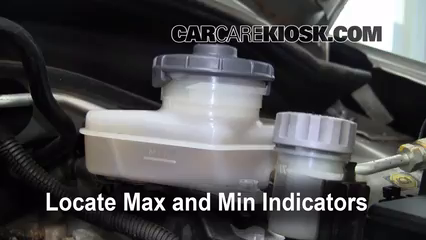

- HONDA CIVIC BRAKE FLUID CHANGE INSTALL
- HONDA CIVIC BRAKE FLUID CHANGE DRIVER
- HONDA CIVIC BRAKE FLUID CHANGE UPGRADE
Hold the bottle with one hand and grasp the wrench with the other hand.ħ. Place the bottle for waste fluid on top of the caliper body or drum assembly. Place the other end of the hose into the disposable bottle.Ħ. Place one end of the clear plastic hose over the nipple of the bleeder screw.ĥ.
/Brake%20Fluid%20-%20Part%201.png)
An offset wrench works best – since it allows the most room for movement.Ĥ. Place the box-end wrench over the bleeder screw. Locate the bleeder screw at the rear of the caliper body (or drum brake wheel cylinder.) Remove the rubber cap from the bleeder screw – and don't lose it!ģ. This will also allow the system to be bled in such a way as to minimize the amount of potential cross-contamination between the new and old fluid.Ģ. (Right rear, left rear, right front, left front.) While the actual sequence is not critical to the bleed performance it is easy to remember the sequence as the farthest to the closest.
HONDA CIVIC BRAKE FLUID CHANGE DRIVER
Begin at the corner furthest from the driver and proceed in order toward the driver. Do not let the reservoir become empty at any time during the bleeding process!ġ. Add fluid as necessary to ensure that the level is at the MAX marking of the reservoir. Open the hood and check the level of the brake fluid reservoir. Note that this step is to limit caliper flex that may distort pedal feel.Ĥ.
HONDA CIVIC BRAKE FLUID CHANGE INSTALL
Install one lug nut backward at each corner and tighten the nut against the rotor surface. Be sure that the car is firmly supported before going ANY further with this procedure!ģ. Loosen the lug nuts of the road wheels and place the entire vehicle on jackstands. * One assistant (to pump the brake pedal).ġ.

* 12-inch long section of clear plastic tubing, ID sized to fit snugly over your car's bleeder screws. * Extra brake fluid (about 1 pint if you are just bleeding, about 3 if you are completely replacing). An offset head design usually works best.

* Box-end wrench suitable for your car's bleeder screws. Note that unless you are replacing your master cylinder, the procedure is the same whether you have a vehicle equipped with ABS or not… So, now that you understand the need behind bleeding your brakes, let us present just one procedure that can be utilized when servicing your own car. But often it is the result of high temperatures that cause brake fluid components to boil, thus releasing gasses from the boiling fluid into the brake hydraulic system.
HONDA CIVIC BRAKE FLUID CHANGE UPGRADE
So how does air enter the lines in the first place? Sometimes, it can be the result of a service procedure or an upgrade – such as replacing the stock flex lines with stainless steel braided lines. Usually, a small amount of air within the brake system will contribute to a "mushy" or "soft" pedal (since less energy is required to compress the air than is required to move fluid throughout the brake lines.) If enough air enters the brake system, it can result in complete brake failure. In other words, when air is present within the system, the efficiency and effectiveness of the braking system is reduced. So when enough air fills the lines, input at the pedal merely causes the air to compress instead of creating pressure at the brake corners. When air (or vapor) becomes present within the lines, it creates inefficiencies within the system because, unlike liquid, air can be compressed. However, for the sake of simplicity we use the term "air" throughout this article to describe both air and fluid vapor. Technically, "air" only enters the lines if there is a compromise of the system's sealing (as when flex lines are removed or replaced), because when fluid boils, it will instead create "fluid vapor." Vapor in the brake fluid, like air, will create an efficiency loss in the braking system. We bleed the brakes to release air that sometimes becomes trapped within the lines. (When you think about it, "bleeding" may appear to be a somewhat graphic term, but it aptly describes the release a vital fluid.) The term "bleeding the brakes" refers to the process in which a small valve is opened at the caliper (or wheel cylinder) to allow controlled amounts of brake fluid to escape the system. In order to keep the fluid in top condition, many enthusiasts have been taught to “bleed their brakes” but many have never stopped to ask the question “why?” The role of the brake fluid within the braking system is to transfer the force from the master cylinder to the corners of the car…and a vital characteristic of brake fluid that allows it to perform its task properly is its ability to maintain a liquid state and resist compression. By John Comeskey of SPS and James Walker, Jr.


 0 kommentar(er)
0 kommentar(er)
